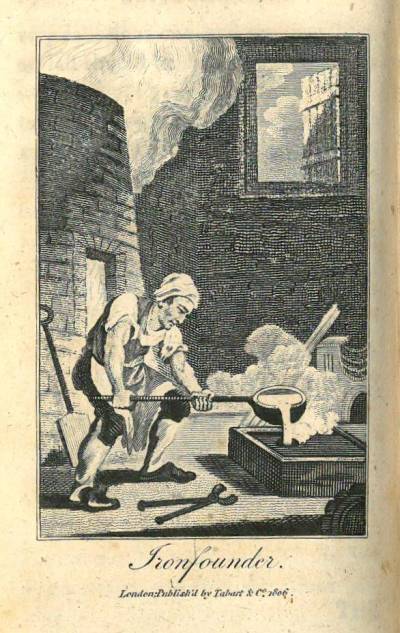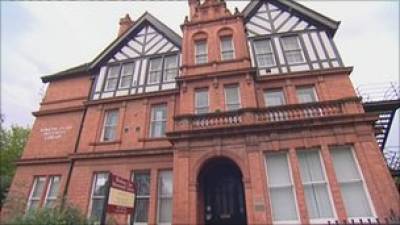The skills developed by different sections of the engineering trade had their origins in millwrights' work. Millwrights worked most of the time in wood rather than metal. They had to make everything themselves from scratch, customised to that particular job.
Differentiation in the engineering workers’ trades began to appear as industrial areas developed in the first half of the 19th century. There was a division of labour into:
-
Pattern makers - made wood patterns or models for foundry use

Iron Founder
- Iron founders – workers in molten ferrous metal, generally working within a foundry
- Brass founders - melted brass to liquid and poured into moulds, made forms and sand moulds around the forms, sanded and polished
- Smiths – a craftsman fashioning useful items out of various metals eg tools, weapons
- Hammer men – wielded the hammer (heavy) in metalworking
- Firemen – tended the fire in a foundry
- Vice men – smiths who worked at a vice instead of an anvil
- Filers (as fitters were originally called) and turners - highly skilled craftspeople who constructed, assembled and fitted components for machinery, vehicles etc. Present day fitters, in comparison with other traditional trades, work in an environment of high accuracy. In some cases they may be required to machine and fit a component within the tolerance that is less than the thickness of a human hair!
 Library co-founder Edmund Frow was an engineer. To quote his obituary in The Times, 'He left school at 14 and, after a year's industrial training course, began work as an apprentice in the drawing office of an engineering firm. He was to become a skilled engineer, reputed by his colleagues to have the finest kit of tools of any man in the industry'.
Library co-founder Edmund Frow was an engineer. To quote his obituary in The Times, 'He left school at 14 and, after a year's industrial training course, began work as an apprentice in the drawing office of an engineering firm. He was to become a skilled engineer, reputed by his colleagues to have the finest kit of tools of any man in the industry'.
As a staunch trade unionist and a Communist Party member Eddie found it even more difficult than others to find work in the years of mass unemployment of the late 1920s and early 1930s, and he became active in Salford's Unemployed Workers` Movement. He resumed work in the engineering industry in the mid-1930s and until his retirement in 1971 his main activities were focussed on his union, the Amalgamated Engineering Union.
Related Object of the Month
May 2012: Photograph of 1934 Manchester wiredrawers' strike
 To mark the Library's Museums at Night ‘campaigning` event on 19 May, involving photographer Simon Roberts, our Object of the Month is taken from our extensive photographic collections and shows a mass meeting. This photo dates from 1934, during the nine-month strike by 650 workers at the firm of Richard Johnson & Nephew Ltd., Wiredrawers, of Forge Lane, Bradford, Manchester.
To mark the Library's Museums at Night ‘campaigning` event on 19 May, involving photographer Simon Roberts, our Object of the Month is taken from our extensive photographic collections and shows a mass meeting. This photo dates from 1934, during the nine-month strike by 650 workers at the firm of Richard Johnson & Nephew Ltd., Wiredrawers, of Forge Lane, Bradford, Manchester.
Resources about Engineering and electrical work in the library collection
Committee on Industry and Trade, Survey of metal industries: iron and steel, engineering, electrical manufacturing, shipbuilding with a chapter on the coal industry - being part IV of a survey of industries (1928) - Shelfmark: C06
Ronald S Edwards and RDV Roberts, Status, productivity and pay, a major experiment: a study of the electricity supply industry's agreements and their outcome, 1961-1971 (1971) - Shelfmark: K27
Labour Party, Reorganisation of the electricity supply industry (1932) - Shelfmark: AG Labour Party Box 15
Samuel Smiles (ed), James Nasmyth, engineer: an autobiography (1883) - Shelfmark: B17
Laurence Meynell, Thomas Telford: the life story of a great engineer (1957) - Shelfmark: B20
Richard Winder, Reminiscences of an engineer at home and abroad (no date) - Shelfmark: C04
Barbara Drake, Women in the engineering trades - a problem, a solution and some criticisms; being a report based on an enquiry by a Joint Committee of the Labour Research Department and the Fabian Women's Group (1918) - Shelfmark: B30
Labour Research Department, Labour and capital in the engineering trades (1922) - Shelfmark: A53
ML Yates, Wages and labour conditions in British engineering, (1937) - Shelfmark: D30
LTC Rolt, Victorian engineering (1974) - Shelfmark: I30
Samuel Smiles, Lives of the engineers: with an account of their principal works - comprising also a history of inland communication in Britain, 3 vols (1861) - Shelfmark: C07
Joseph Nasmith, George Stephenson: mechanical practicality and modern speed - a lecture delivered at New Islington Hall, Manchester, before the Ancoats Recreation Society, on Sunday, December 11th, 1898 (1898) - Shelfmark: AG Ancoats Brotherhood Box 1

